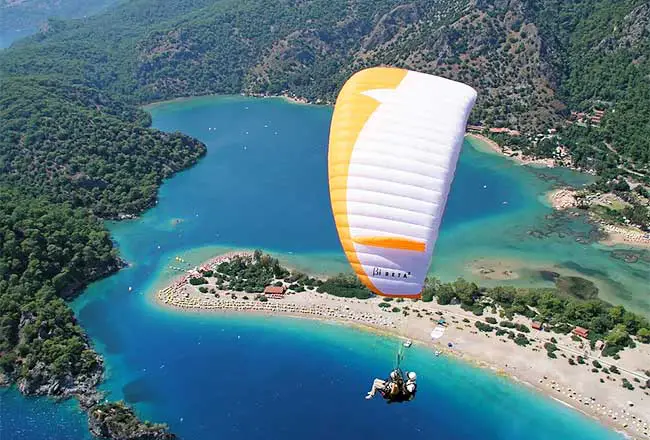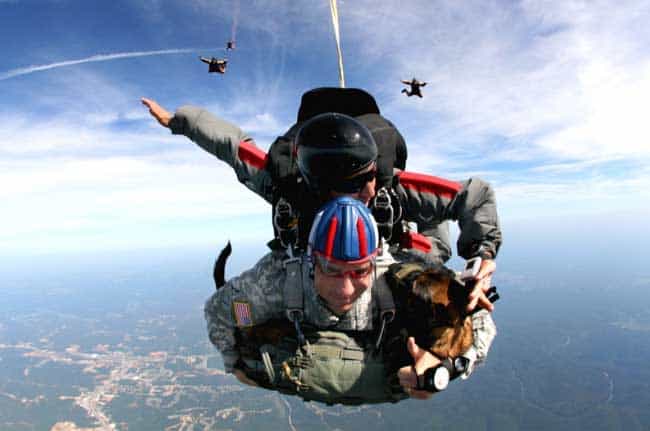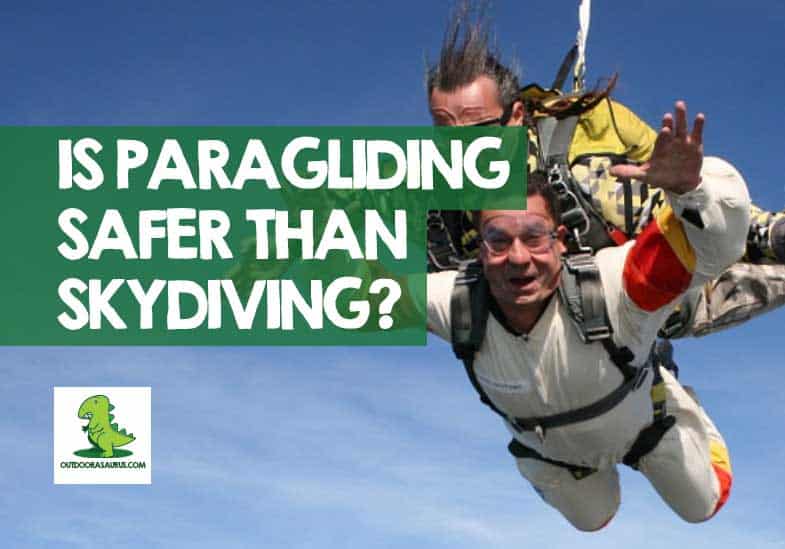Paragliding and skydiving are both adrenaline-fuelled sports. Whilst skydiving is more high-octane, both do inevitably carry risks. However, if you are a newbie considering an adventure into the unknown, or a novice who wants to know the full ins and outs of your new hobby, how safe is paragliding vs sky diving?
Is paragliding safer than skydiving? Both paragliding and skydiving, despite the potential risks, are statistically very safe. In fact, they can carry a lower fatality risk than driving. However, statistics suggest that paragliding (0.0074% deaths) isn’t safer than skydiving (0.0004% deaths).
Both are activities millions of Americans perform every day without any sense of danger whatsoever. You can read on to see where I got these safety statistics from, but if you don’t have time to read in depth, here’s why I say skydiving is safer than paragliding.
- Skydiving: 3 million skydiving jumps taken per year only 13 fatalities (0.00039% fatality rate)
- Paragliding: 18 fatalities were recorded out of a total of 242,355 paragliding flights (0.00742% fatality rate)
Still, it would be untrue to call either sport entirely safe. Part of any kind of adrenaline sport is that risk of danger. Safety precautions must be taken no matter if you are a complete novice with an instructor or an experienced novice pilot or diver who has dozens of flights already under your belt.
So, what are the risks of paragliding and skydiving, which is safer, and how can you make sure that you are at as little risk of injury as possible?
Paragliding vs skydiving – what’s the risk?
In terms of which sport carries the most risk, skydiving has a somewhat higher level of fatalities, however this is only in comparison to one another.
Due to decades of experience and the refining and upgrading of equipment especially over recent years, the real risk of danger for both sports is incredibly low, especially for first-time flyers.
However, it is still important that you are completely informed and aware of the potential risks when taking part in either skydiving or paragliding, so that you can fully enjoy the experience and be sure that you aren’t taking any unnecessary risks. That being said, how safe is paragliding and skydiving?
How safe is paragliding?
Paragliding is a very popular tourist sport, especially in places of natural beauty which are best seen from the air. Paragliding involves the use of a large, single winged fabric paraglider, which you are strapped into via a harness and use to fly yourself around the open-air by using air currents. You will also have a reserve parachute for peace of mind.
First patented in the 1950’s paragliding equipment has become incredibly sophisticated, designed to be as safe as possible.
However, because of the free-flying nature of the sport, there are certain levels of risk posed to novices which mean that precautions and safety measures need to be closely followed so that you get the most enjoyment out of the experience without posing danger to yourself or others.

Paragliding is most popular in Europe, where studies on paragliding in Germany measured that out of 11,000 pilots there are only 3 fatalities in a year, out of around 33,000 pilots.
This may seem like a lot, but with US car accident rates being around 1 in 10,000, this is in fact statistically safer than driving, an activity million of American do every day without any fear.
According to the US National Library of Medicine Paper on Injuries Caused By Paragliding Accidents (view source), only 18 fatalities were recorded out of a total of 242,355 paragliding flights, with an additional 64 injuries.
The majority of non-fatal injuries were minor scrapes and sprains, with the rest being upper and lower extremity fractures. Out of the 18 recorded fatalities, the majority were caused by multiple injuries, with only 1 suffering head and neck trauma and 2 suffering chest / thorax injuries.
95% of these kind of accidents are down to human error, with equipment malfunction being extremely rare. In fact, many instructors consider the biggest risk as ‘intermediate syndrome’, where novice solo flyers let down their guard due to a false sense of security when flying.
Because of this, 90% of accidents happen within the first 10 flights; meaning that it is important that you exercise caution at all times, even when you think you know what you are doing.
If you are a first-time or one-off paragliding flyer, then the risk posed to you during the experience is incredibly low, with the accompanying instructor having years of experience and knowledge of safety precautions.
If you are still unsure about your paragliding experience, it is recommended that you contact the company that you are booked with, and they will talk you through all of the safety procedures and benefits of paragliding.
There is not real age limit to paragliding, with children as young as 5 able to take part (with a parent of guardian present) and with older passengers up to 90 years old. Anyone under the age of 18 will need to have written parental consent to paraglide.
Handy Hint: Click here to see what the age restrictions are in countries around the world regarding paragliding.
How safe is skydiving vs paragliding?
Because of the nature of skydiving, as well as the slightly higher fatality rate, many people assume it to be a ‘dangerous sport’.
However, the fatality rate is only considered higher relative to paragliding, with the danger posed to first-time jumpers when skydiving is still incredibly low.
What are the chances of dying while skydiving?
According to the American Parachuting Association’s Summary of Data between 1999 and 2018 (view source), out of over the 3 million skydiving jumps taken per year only 13 fatalities were recorded in 2018, the lowest rate since 2000 and almost half the rate since the 1970s.
This makes the rate a 1 in 100,000 chance of a fatality if you took one jump per year.

Fortunately, tandem jumps are the safest form of skydiving and is typically the first experience for any first-time skydivers. Here, you are strapped to an experienced instructor who is able to guide you through the fall.
Only 1 in 750,000 tandem jumps result in a fatality, with an injury rate of 1 in 1,100 jumps; so even the risk of hurting yourself is still incredibly low.
“Tandem parachuting appears to give one of the lowest risk profiles for novice parachutists… display parachuting remains a relatively “high risk” area for experienced parachutists but there has been a steady reduction in injury rates on displays over the last 5 years.” John Carter, the American Parachuting Association (2019)
The age limit for skydiving in both Europe and the United States is 16 years old, with anyone under the age of 18 needing written parental consent before they can dive.
How can I be sure I am safe?
If you are a first-time jumper or pilot, then the risk to you during your flight is far lower than that of novice hobbyists or experienced professionals. The low risk comes from both the fear of jumping, resulting in you following safety precautions extremely closely, and the fact that you are with an experienced professional who is completely at ease in the air.
Injuries and fatalities are often highest with novice solo-flyers, making a one-off jump extremely safe in comparison.
Many paragliding and skydiving companies are equipped to deal with health and mobility issues, including wheelchair users, so if you are concerned that you may not be able to fly then it is best to talk with the company you are flying with so that they can make the relevant accommodations for your experience.
If you are looking for a 100% safe experience without any risk, then skydiving and paragliding may not be for you. Indoor skydiving facilities are very popular, and although it doesn’t quite match the real experience it gives you the same ability to fly without any of the danger.
However, if you are sure you want to take part but are still apprehensive about your safety, then it is recommended that you speak to the skydiving team you are considering jumping with and they will give you a complete low-down on the risks and rewards of taking the jump.
Related questions
If you are thinking about which is better, paragliding or skydiving, and now appreciate how safe they are compared to each other, then these additional questions might help you make your mind up.
Is skydiving scary?
The concept of jumping out of a plane is going to naturally seem utterly terrifying for most people, as it should. Human survival instinct is going to advise us to not throw ourselves out of a plane (even seasoned skydivers still get that fear).
But the truth is that, once you have jumped, that fear often goes away. In fact, the skydiving itself is often not scary at all, it is more the fear if jumping.
One of the best bits about skydiving is that adrenaline rush you get, when reaching terminal velocity it often doesn’t feel like you are falling at all. Even if you are not an ‘adrenaline junky’, the feeling of skydiving really is second to none.
You can compare skydiving vs paragliding feelings by checking out this new blog post I recently wrote: what does paragliding feel like?
How high is skydiving?
While Felix Baumgartner made history in 2012 by skydiving from 128,000 feet (39,000 meters or 24 miles) in the air, most skydiving takes place at around 2 miles above the ground (around 10,000 feet or 3,000 meters), although it can be as high as 18,000 for the more experienced jumpers looking for a longer fall.
Usually, the free-fall section of skydiving takes between 30 seconds to 60 seconds, before parachuting safely to the ground. At 18,000 feet, the fall is around two minutes.
How long does paragliding last?
While skydiving is definitely a short-but-sweet experience, paragliding is a longer and calmer experience. With a typical height of around 1700 meters (5,000ft or 1 mile) above the ground, your paragliding flight usually takes between 10 to 15 minutes.
This means that you get to spend far longer in the air than you do when skydiving, and while you don’t get the same kind of adrenaline rush, you do get a calmer flight and a nicer view.
Also, once your flight is over you can easily go for another one straight away if the conditions are still nice and there is enough time between bookings.
Conclusion
I hope this has helped to put your mind at rest. If you wanted to know what the chances of dying are while skydiving, then it appears to be very low!
Whether you think the difference in safety between paragliding vs skydiving is a deal breaker is entirely up to you…
And if you’re still apprehensive, how about checking out whether hang gliding is safer than paragliding too? Then you have 3 new potential sports to choose from!

